WW2 US destroyers
The US Navy Destroyers represented the formidable industrial effort consented by the United States to win the war on two oceans. They were versatile and highly standardized, to the point as producing only four wartime classes of 50+ up to 180 ships, the Bensons, Fletcher, Sumner and Gearing, completed by the numerous “peacetime classes” from 1934 to 1940 and the WW1-era famous “four-pipers” of which many were completed up to 1922 and which would serve again in WW2 in many roles. From design to armament and tactics, destroyers to destroyer escorts here is naval encyclopedia portal on american destroyers (many individual posts with treat these classes in detail in the future).
Introduction
USN Destroyer development passed through a long eclipse: Basically after the mass cancellations of November 1918 and the end of the war, WW1 USN destroyers of the Caldwell, Wickes and Clemson classes, the famous “four pipers” made the bulk of the USN destroyer force, which had been reduced compared to other nation’s efforts, in comparison to battleships.
The most advanced were completed sometimes two years after the war, but soon mothballed as there was no more use for them in a peacetime world; This is probably the main reason behind the 10 years-eclipse before new destroyers were laid down again, approved by the Congress only to keep pace with foreign destroyer development, not least the Japanese.
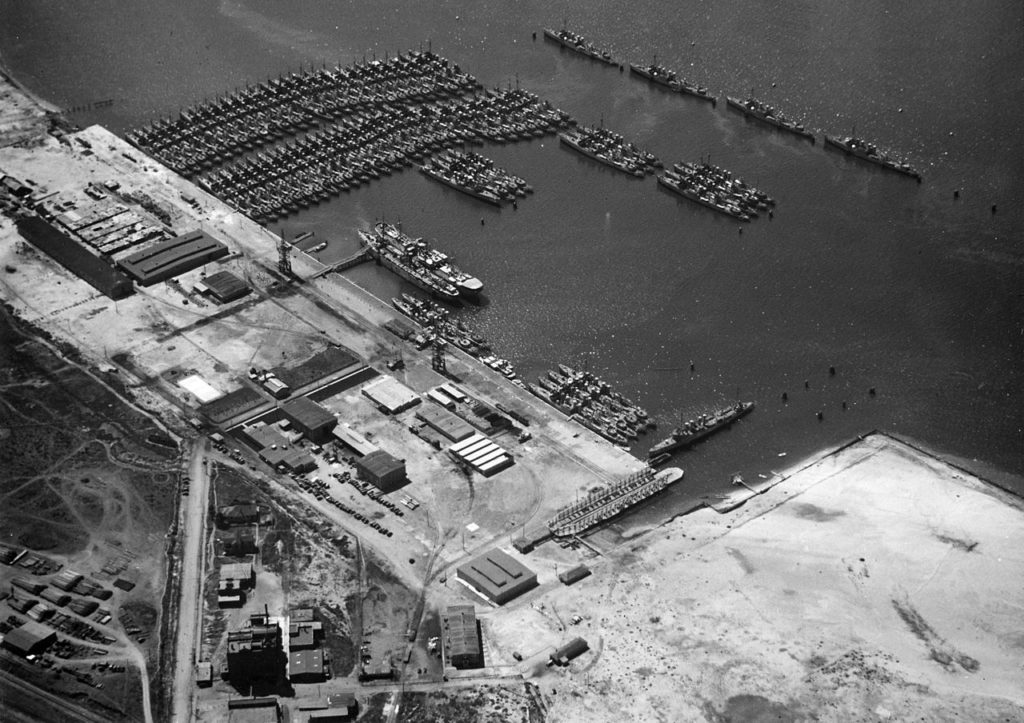
Large scale ww1 “FLUSH DECKERS” destroyers mothballed in 1924 in San Diego naval base. In 1940, 50 were sent to the Royal Navy under the lend-lease agreement, and many others were used in various conditions (see later);
A gradual evolution
Contrary to Germany for her own ww1 versus interwar designs, Japan, with the Fubuki or Russia with the Novik, the United States Navy progressed by gradual improvements, an incremental approach which was also favoured by the Royal Navy. The famous “four pipers” of 1917 were no more than the evolution of the previous 1500 tons 1911 designs, with a flush-deck hull as only difference, save for mass-production simplifications.
When it was time to start again completing new classes of destroyers in the mid-1930s, it was done by still comparable ships with two-stepped hulls and single masked guns, and only the two funnels to make a difference.
These classes of generally eight ships followed one another, in between classes of “leaders” (four ships each), slightly larger destroyers were also built, reflecting the general direction of all fleets about a double standard in destroyer to lead their squadrons and prey on enemy destroyers as well.
These early models however suffered from the same default, a hull lightly built, and poor stability, so much so for the flotilla leaders of the Porter class for example, ship-to-ship engagements were near-impossible despite of their excellent and powerful artillery.
Surviving destroyers, standards and leaders alike, were often modified during wartime, in 1943-44, having their torpedo tubes removed and replaced by AA, artillery deposed and replaced by modern semi-auto twin turrets, superstructures rebuilt and made lower and ASW armament (and AA) considerably improved.
At the eve of December, 7, 1941, the USN counted a rather impressive fleet already of 166 destroyers, the bulk of which were the now obsolescent Clemson/Wickes types (71), the new Farragut class (8), Porter (8), Mahan (18), Gridley (4), Bagley (8), Somers (4), Benham (10), and Sims (12). The latter were the last with conventional hulls, the next Benson/Gleaves (23) already announced mass-production with their flush-deck hull.
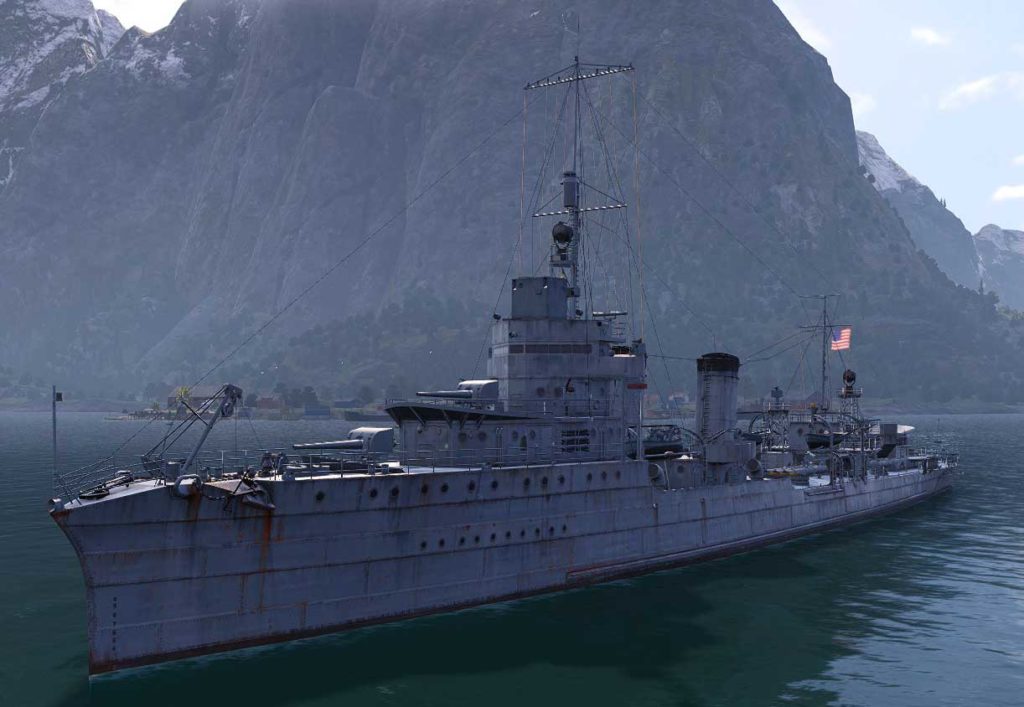
3d restitution of the USS Nicholas (World of Warships)
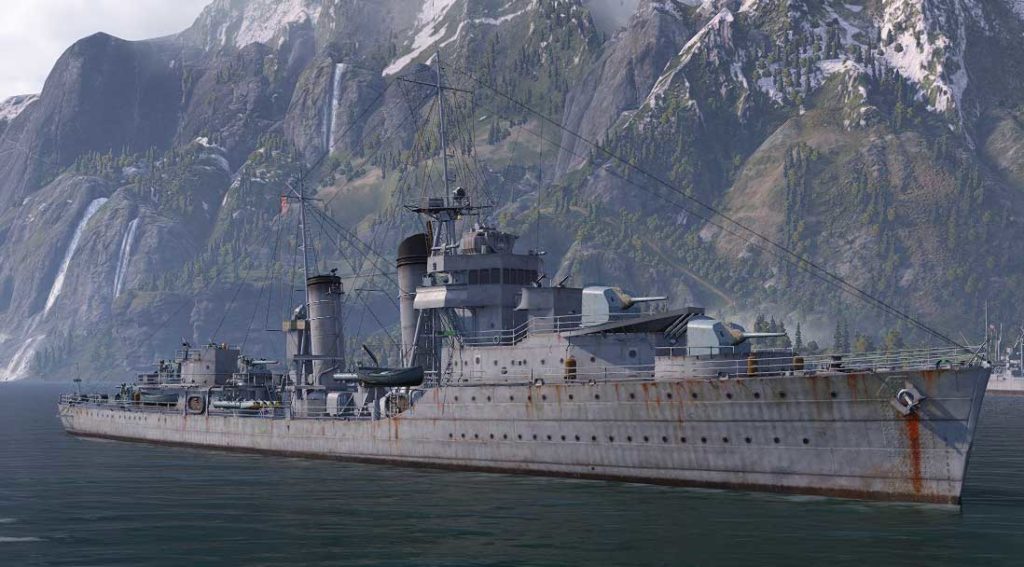
USS Mahan
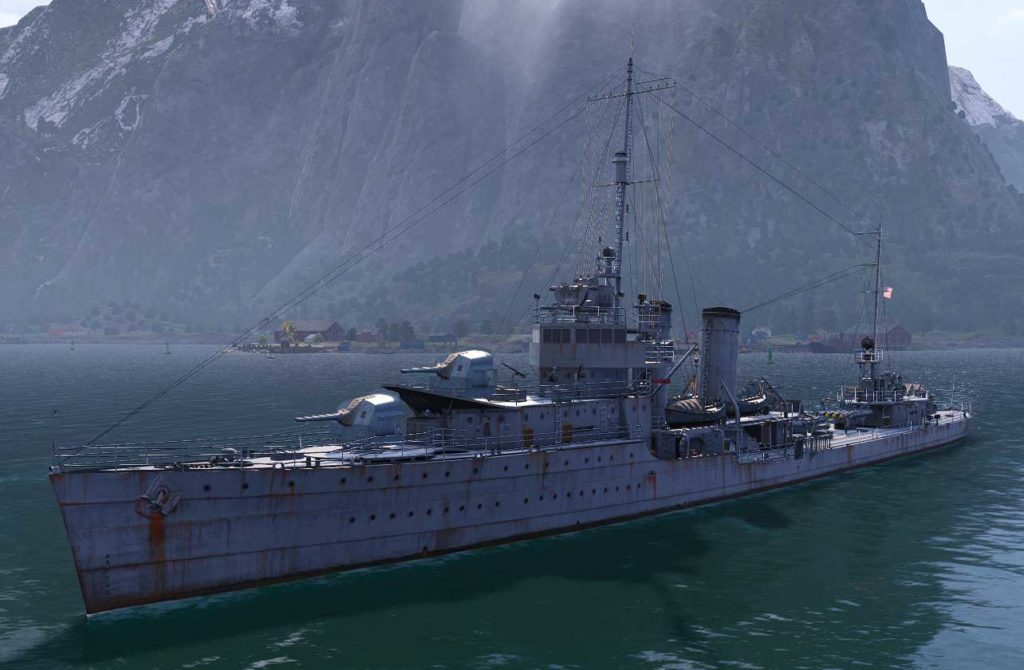
USS Farragut
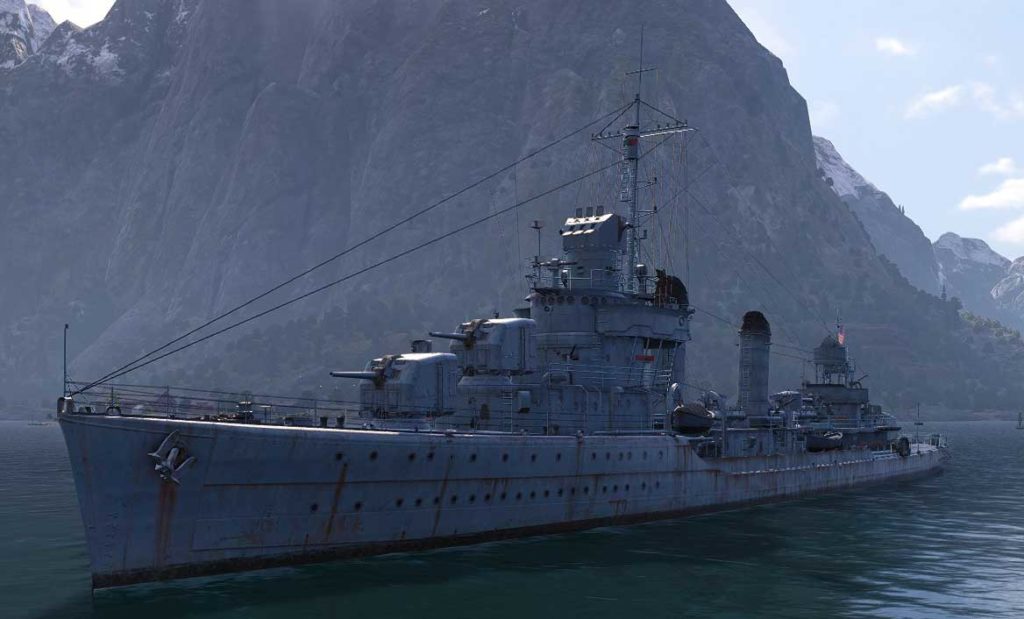
USS Benson
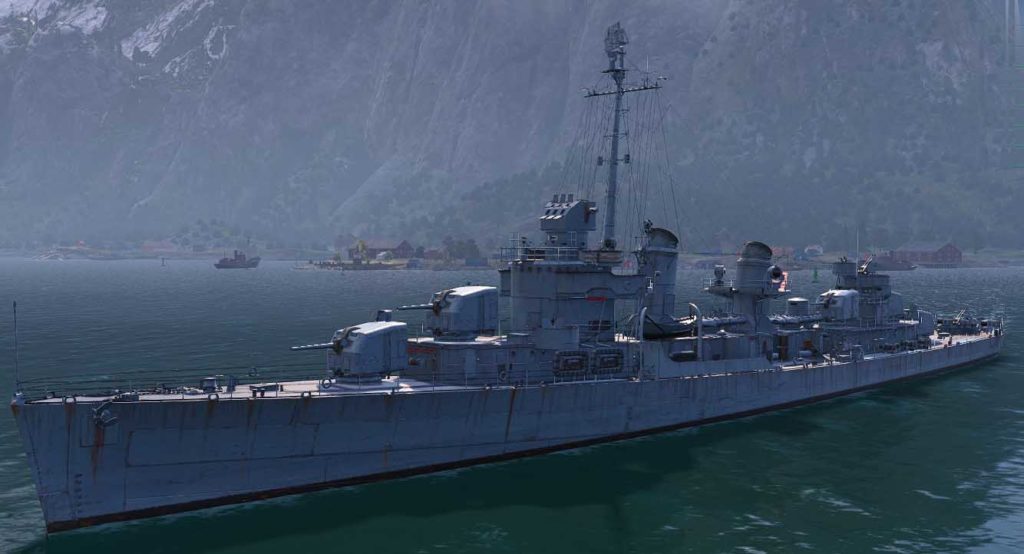
USS Fletcher
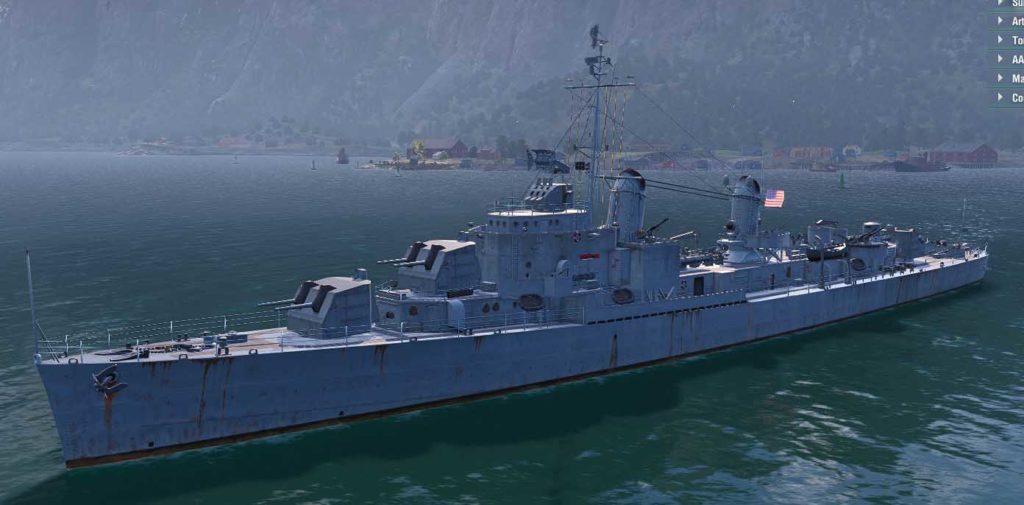
USS Gearing
The war of course concentrated construction of a few types built in mass construction principle, simplifications and reliable, proven systems. Innovations were real, but generally not outstanding and rather gradual in their implementation throughout the war.
The first of these wartime destroyers (and most celebrated), after the remnants of the Bensons/Gleaves (98 total) was of course the Fletcher (175), followed by the 1944 Allen M. Sumner class (58), and 104 Gearing class which like the previous class innovated by the adoption of twin duel-purpose turrets, a trend that was already perceptible at the start of the war.
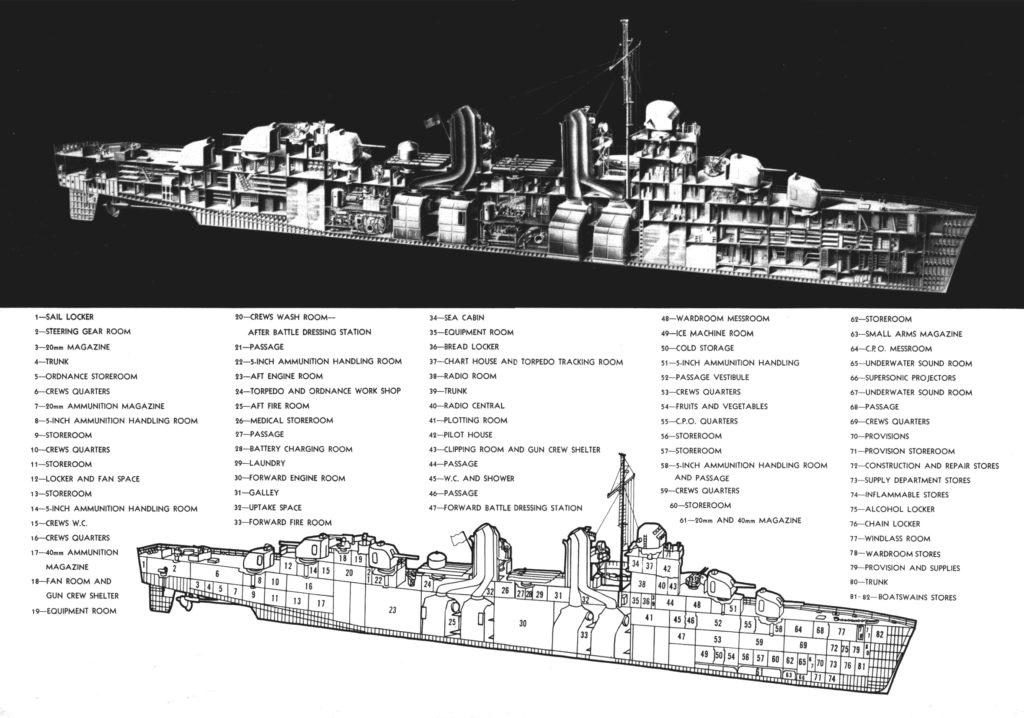
Fletcher class cutaway – Popular science archive
These three classes were clearly separated. The Fletchers were still very much interwar American destroyers types with their five single turrets, even using a modernized semi-auto mount. They were however extremely decorated ships, providing all the heavy-duty daily fighting in the pacific until 1945.
Most were scrapped after the war, although some lived longer under other flags, but they were seldom exported. However many were also modernized to take into account the new propulsion systems likely to be adopted by Soviet submarines, using the German Type XXI tech.
Interwar Types evolution
The USN designed in 1932 a very different ship, sturdier and with a forecastle, a heavier artillery, but also integrating the limitations of the 1931 London Treaty. This was the Farragut class (1934). Soon, like most of foreign navies, the need of flotilla leaders led to built much heavier destroyers with almost a cruiser-size artillery, in twin turrets.
To the Porter class (1935) succeeded the Somers, in short series, and plagued by stability problems right from the start. They were completely rebuilt during the war. Meanwhile the standard classes would evolve through the Mahan, Gridley Bagley, Benham and Sims, until the first wartime serie, the Benson/Gleaves, oscillating between 4 or 5 5-in guns and quintuple TTs.
Wartime Types
Wartime series were clearly separated into two very different classes: The Benson/Gleaves and Fletcher were continuations of the interwar design with their single-mount 5-in guns, just more power and room, a simplified hull, improved AA and ASW. But the next Allen M. Sumner and Gearing were completely different animals, arrived late into the war, entering service from 1944. They signalled the return to twin mounts of the same caliber, but with semi-automated, fast firing standard models that were found also on cruisers, battleships and even aircraft carriers.
Lessons of the early part of the war has been learnt and AA was reinforced considerably, to the detriment of both AAW and ASW capabilities. Meanwhile, using fleet destroyers for ASW warfare has been seen as a costly and an overkill, and this led to the design of numerous classes of dedicated Escort destroyers, which were aldo standardized and costed sometimes 2.5x less than a single fleet destroyer. As many as 424 left various yards until 1945, mostly to be used in the Atlantic, which freed fleet American destroyers for the pacific.
General design
USN destroyers tended to be slightly heavier than European destroyers, British, French, Italian and Russian models for their standards. However the ten USN destroyer leaders as said above were heavily armed on a somewhat cramped hull, very tall superstructures. Needless to say they were top heavy and they were highly unstable, rolling badly, making them poor firing platforms. Only with major reconstructions in the 1940s these defects were corrected.
During wartime, of course USN destroyer design was no longer contingented by any treaty limitations and the admiralty was free to order larger designs. The 175 Fletcher class were “2100 tonners”, the most famous an ubiquitous destroyer class of the war, especially in the Pacific where their larger side traduced into a larger autonomy. In the end of 1942 with the crude light of fighting, the U.S. Navy commissioned 67 brand new designed six-gun destroyers, the Allen M. Sumner class which were 2200 tonners.
They were stable and well armed platforms but too slow. Closely derived from them were the 2250 tonners, 45 Gearing class ships (out of an order for 200+) which signed a return to the speed of the Fletchers. By that time, the flush deck design was so embedded in destroyer design that the USN next cold war generations all caled for the same hull. Only the Spruance class in the 1970s marked a new milestone.
Armament of WW2 US destroyers
5″/50 caliber naval gun (127 mm)
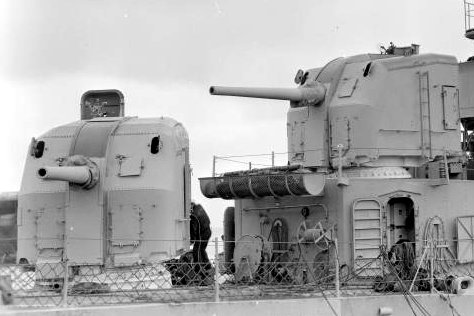
Fletcher class DD single mount, semi-automated 5-in gun.
The staple of WW2 USN Destroyers was the 5-in gun, a relatively heavier caliber than British ships 4.7 in, but the same as axis destroyers, 127 mm. It came at first in masked versions in interwar destroyers, then was perfected into a semi-auto enclosed turret version, and the famous 1942 twin-mount, turreted, which saw service in some navies until the 1990s.
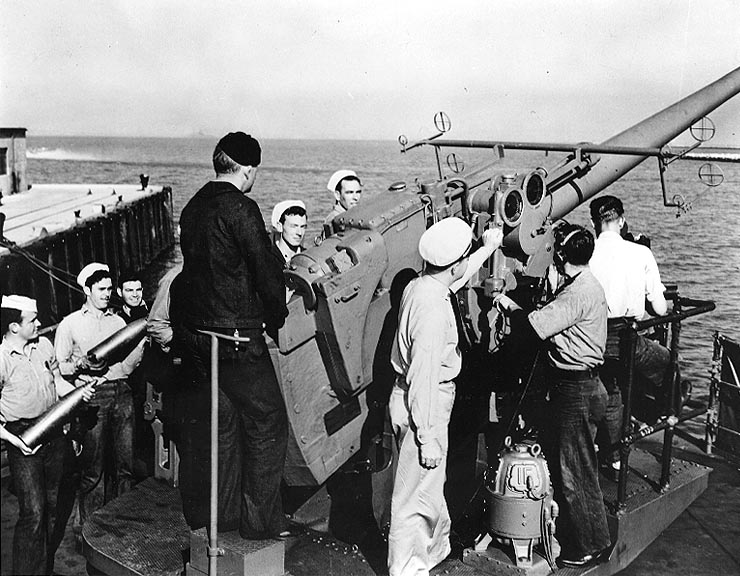
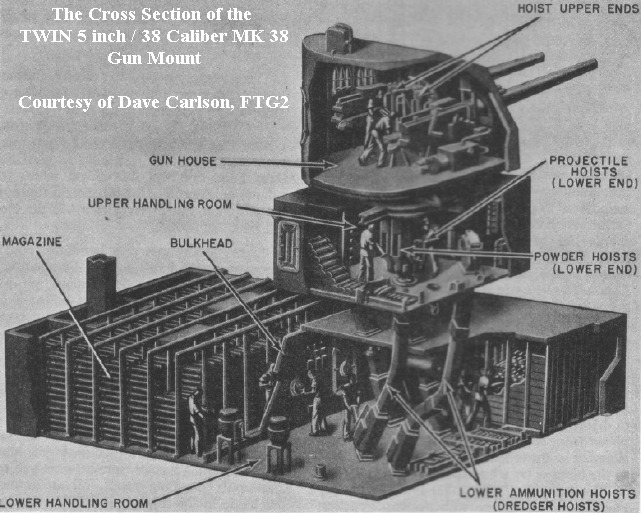
5-in/38 cal. gun (127 mm)
4″/50 caliber naval gun (102 mm)
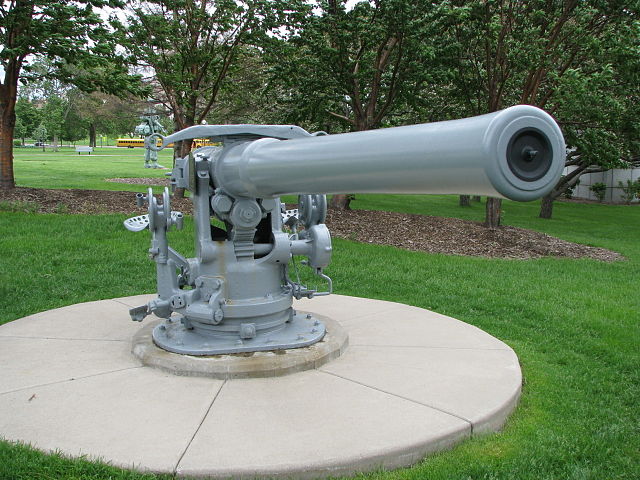
USS Ward’s ex-4-in gun at Minnesota capitol. This gun fired the first American shot of World War II at Pearl Harbor
This piece of artillery became the standard low-angle, quick-firing gun, used in sponsons or single, unmasked mounts on superstructures. It was based originally on the M1898 model and the Mark 8 appeared in 1907. It was adopted on the monitor USS Arkansas, but quickly superseded by the Mark 9 in 1910. The 2.7 ton piece of ordnance had a full-length jacket, muzzle swell with a side swing and Smith-Asbury breech mechanism plus Welin breech block.
It appeared first on October 1911 and production went on, with 400 produced by 1917, 1,885 guns until the armistice and 773 after, for the four-piper destroyers, which had four each. Since these “flush-deckers” saw also heavy action during WW2, lend-lease transfer meant they were fired also by British, Canadian and Soviet gunners. Not only they equipped the Caldwell class, but also all the previous lines of destroyers since the Cassin, and S-type submarines as well as the first preserie Balao-class of ww2 fame.
They fired a 33 lb (15 kg) projectile, which was 62.4–64.75 lb (28.30–29.37 kg) complete. The gun could elevate -15° to +20°, with full 300° traverse and a rate of fire of 8-9 rounds per minute, 2,900 ft/s (880 m/s) muzzle velocity, 9,000 yd (8,200 m) at 13° elevation up to 15,920 yd (14,560 m) at 20° for the Mark 9. The Mark 10 was ordered in 1915 but not ready before the war ended and seems to not have been used in service. Mark 8 and 9 gun were 206.53 in (5,246 mm) long, and the Mark 10 was 211 in (5,400 mm) /60 caliber whereas the previous ones were /50 cal.
3″/50 caliber naval gun (75 mm)
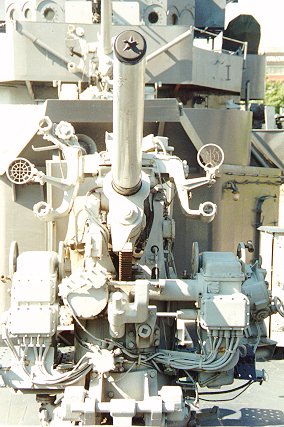 This piece of naval ordnance was the longest-serving in the US Navy: 100 years, from 1890 to 1990. The initial model was devised in 1890 as a light anti-torpedo QF gun to be placed on superstructures and tops of battleships and cruisers. It evolved considerably over time, with improvements in all areas. The Mark 2 entered service in 1898, when the Spanish-American war just broke out, and went on until the Mark 22 in 1944. But some ships used it (notably the twin mount Mark 22) until 1990, as some navies retained WW2-era destroyers modernized with it. For example, the Greek Kimon and Nearchos which were former German, ex-USN Fletchers, rebuilt in the late 1950s and 1970s.
This piece of naval ordnance was the longest-serving in the US Navy: 100 years, from 1890 to 1990. The initial model was devised in 1890 as a light anti-torpedo QF gun to be placed on superstructures and tops of battleships and cruisers. It evolved considerably over time, with improvements in all areas. The Mark 2 entered service in 1898, when the Spanish-American war just broke out, and went on until the Mark 22 in 1944. But some ships used it (notably the twin mount Mark 22) until 1990, as some navies retained WW2-era destroyers modernized with it. For example, the Greek Kimon and Nearchos which were former German, ex-USN Fletchers, rebuilt in the late 1950s and 1970s.
The Marks 2, 3, 5, 6, 8, 10, 17, 18, 19, 20, 21, and 22 succeeded in order, and most saw action during the war, from WW1-vintage ships equipped with earlier models to the mass-produced 3-in/50 which was the standard for submarines had succeeded the early WW1 and pre-war 3″/23 caliber gun. The 3″/50 caliber gun Mark 21 became the standard on USN submarines from 1935 to 1942, mounted mounted aft of the conning tower or a forward position at the commanding officer’s option but it was used as secondary AA gun whereas the 5″/25 caliber gun became the standard deck gun on USN submarines. The Mark 18 and 19 appeared at the end of WW1, and equipped S and R-class submarines. They still saw USN and British service during WW2 (with lend-lease transfers).
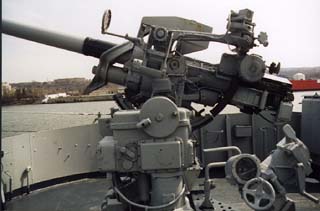 But they were best known as 3″/50 caliber standard dual-purpose guns (Marks 10, 17, 18, and 20) for surface ships, starting with the Battleship Arkansas, first to adopt it. They were mounted on most battleships of that prewar and wartime era, as well as on Clemson and other destroyer classes. But they also found their way on destroyer escorts, patrol frigates, submarine chasers, minesweepers, and many other auxiliaries as well as Coast Guard vessels. At the end of the war, development of a fast-firing, long range, high velocity version dedicated to destroying Kamikazes when the 40 mm Bofors failed ended with the Mark 22, in single but soon in twin mount. It was soon widespread on modernized WW2 ships, replacing the quad-bofors. Later, it was further developed as the 3″/70 Mark 26 gun used by many cold war USN vessels, a dedicated AA version.
But they were best known as 3″/50 caliber standard dual-purpose guns (Marks 10, 17, 18, and 20) for surface ships, starting with the Battleship Arkansas, first to adopt it. They were mounted on most battleships of that prewar and wartime era, as well as on Clemson and other destroyer classes. But they also found their way on destroyer escorts, patrol frigates, submarine chasers, minesweepers, and many other auxiliaries as well as Coast Guard vessels. At the end of the war, development of a fast-firing, long range, high velocity version dedicated to destroying Kamikazes when the 40 mm Bofors failed ended with the Mark 22, in single but soon in twin mount. It was soon widespread on modernized WW2 ships, replacing the quad-bofors. Later, it was further developed as the 3″/70 Mark 26 gun used by many cold war USN vessels, a dedicated AA version.
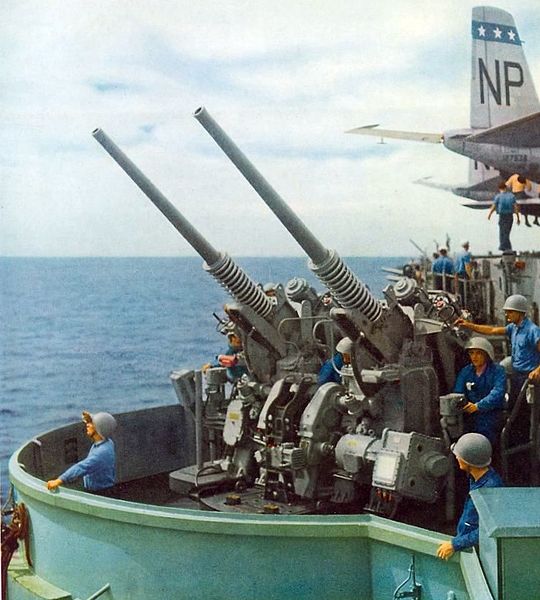
The ultimate cold war Mark 33 twin-mount, fast firing version deployed on many USN vessels, was faster than the quad-40 mm Bofors and harder hitting, at twice the range. It seems fit to deal with early jets but was replaced by missiles in the 1960s, like the Terrier.
2″/50 caliber Bofors (40 mm)

40 mm quad Bofors
The anti-aircraft autocannon designed in the 1930s by the Swedish arms manufacturer AB Bofors became a legend, widely used on all sorts of ships, from aircraft carriers to humble MTBs and minesweepers or sub-chasers. As a testament to its reliability and hard-hitting qualities, it is still in service around the globe today in many configuration. Called “Pom-pom” in the Royal Navy where it was used in often octuple mounts for compacity, it was the staple of AA defence in medium-close range, the last line being provided by the also ubiquitous and long-living 20 mm Oerlikon, this time of Swiss origin. Both the Bofors, most often in quad mounts, and the Oerlikon shaped the AA defense of allied ships during WW2. Their limitations were recognised but the volume of fire they provided procured a solid last-ditch steel wall.
In the USN, the 40 mm was adopted during the war after seeing the British model in action. Chrysler built 60,000 of the guns and 120,000 barrels through the war, at half the original projected cost, filling the Army and Navy’s needs by 1943, resting on a large network as shown by the 2,000 subcontractors in 330 cities supplying Chrysler. By productivity alone, manufacturing time was halved until 1945. Chrysler’s engineers indeed simplified the manufacture, improved performance and allowed others to copy the model with minimal licencing fees.
Although it was used also in single and twin mounts (like on the Fletcher class), when toom was available, on late Destroyer types, cruisers, battleships and ACVs, the bathtub-like MK 12 quadruple mount became standard.
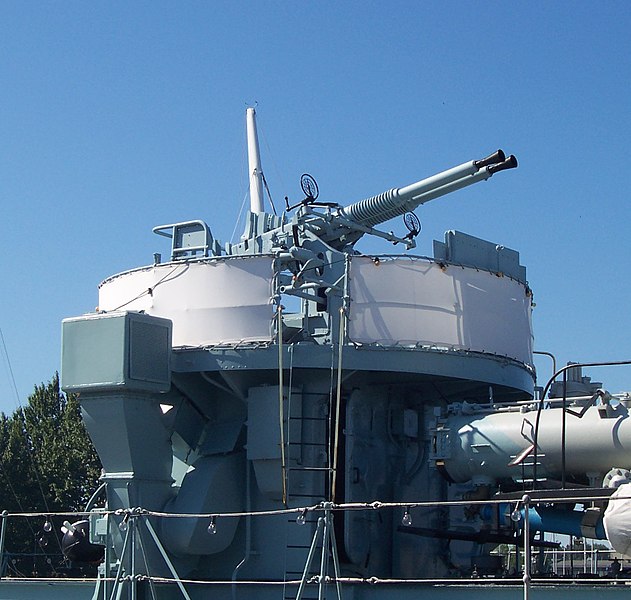
Twin Bofors variant used in the Fletcher class (Here, Polish destroyer ORP Blyskawica).
The Bofors needed five men to operate effectively: A gun commander, adjusting the range and angle, two gunners, one responsible for the traverse and another for the elevation, and two loader, on each side, filling and replacing ready-round clips magazines, each with four. This provoked most often than not 16-round bursts cycles, but 900 g (2.0 lb) high explosive 40 × 311R (rimmed) shell at 2,960 ft/s (900 m/s) could reach 120 rpm with a well-trained crew. They could hit a target at 7,200 m (23,600 ft), but the practical maximum was about 3,800 m (12,500 ft). It came in 60 and 0 caliber barrel lenghts.
The 40 mm was gradually replaced in the USN at the beginning of the cold war, notably by late version of the 3-in (see above). Production and uprades were maintained for land uses, and the venerable piece of ordnance is still manufactured by Zastava Arms, United Defense Industries and BAE Systems AB.
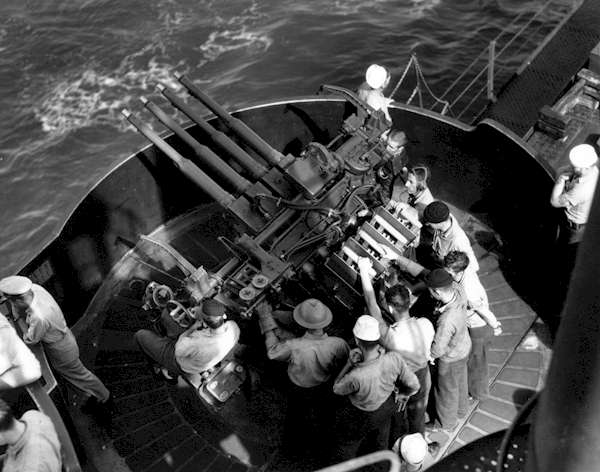
1.1″/75 caliber gun ‘Chicago Piano’ on board USS Enterprise. It was quite rare on american destroyers.
1.1″/75 caliber gun ‘Chicago Piano’
This relatively rare ordnance, 28 mm caliber, designed to replace the designed to replace the M2 Browning and therefore placed always in quad mountings to reival the rate of fire of the latter, the 1.1 ca. started to be installed in 1938 onboard many ships of the USN and was mounted at the range of one mount for a destroyer, and around 1000 produced total which ceased on 1942 as the USN hade found the perfect combination with the quad-40 mm Bofors and single 20 mm Oerlikon. Even after its problems had been ironed out, the navy flagged it in reports as too heavy to be used as a “last-ditch” free mount and too light to fill the void between MGs and and the 5-inch guns.
1″/70 caliber Oerlikon (20 mm)

20 mm Oerlikon gun
The famous “Oerlikon gun” was the proverbial light AA gun of the US Navy during the war and is still on service today in many navies around the globe, a testament of its core design and usefulness. Packing quite a better punch than the legendary heavy AA machine gun, the 1920 Cal.50 (12.7 mm) M2HB Browning, this 20 mm gun (1-in) started during WW1 as the “20 mm Becker” using an Advanced Primer Ignition blowback. It was fed with 20×70mmRB cartridge and had a cyclic rate of fire of 300 rpm, used by several Luftstreitkräfte planes and as AA ordnance in 1918. However the Versailles treaty banned the development of such armament, and the licence was sold to Neutral Switzerland, Seebach Maschinenbau Aktien Gesellschaft of Zürich (SEMAG).
The firm relaunch development in 1919 and produced the heavier SEMAG L in 1924. But the companu filled a bankrupcy and its assets were taken over by a new company that took the name of a suburb of Zürich, Oerlikon. In 1927, the firm launched the heavier Oerlikon S, using a 110 mm cartridge, with a slower rate of fire but faster muzzle velocity, almost double of the Becker design of 1918. It was proposed on the market as AA and AT gun. The range later comprised the AF and AL as aircraft mounted guns, and the success was quick. It evolved in 1935 into the FF, FFL and FFS family, still for aircrafts. In France it was licenced to Hispano-Suiza, as well as in Germany, Ikaria and in Japan as Type 99-1 and Type 99-2.
But for ships, as AA gun, the Oerlikon SS (1938) came as the standard shielded version for Navies. It was widely adopted and licenced as is, and evolved, refined into the 1SS of 1942, and the 2SS of 1945. It was also widely adopted during the war by the Royal Navy as a short-range anti-aircraft gun, complementing the ubiquitous “Pom-Pom”. Deliveries started in 1940 at slow pace, imported from Switzerland, and it started under licence in the UK, at Ruislip, London. In the US Navy, the 20 mm SS logically replaced the M2 Browning machine gun and was manufactured in US state arsenal and contracts went to numerous automobile manufacturers including Hudson and General Motors.
Total production during the war reached about 100,000 to 120,000 according to several sources. This was enough to be fitted on all USN major warships and destroyers. It was coupled with the MIT-designed electric Mark 14 gunsight. The latter triangulated an aiming point on a fast-flying aircraft, thanks to two gyro stabilization. The usual provision of USN destroyers was 5-6 on the old “four-stackers” and their wartime variants, 4-6 on some modernized interwar american destroyers, 4 on the Benham, Fletcher, and 11 on the Sumner and Gearing classes.
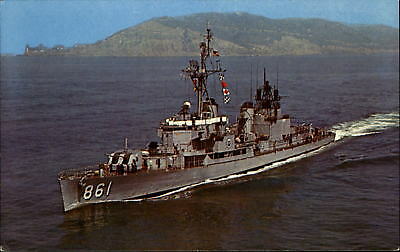
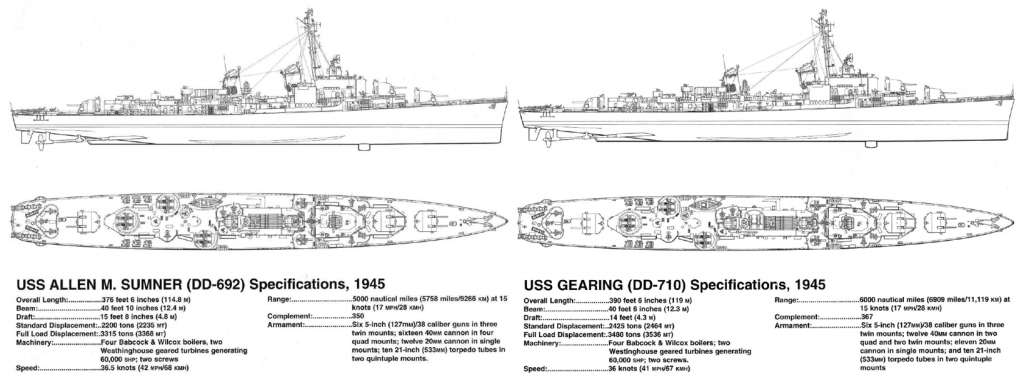
Sumner-Vs-Gearing comparison
Browning .50 Caliber Machine Gun
The legendary heavy machine gun, adopted in 1920 and still used today, nearly 100 years later and probably for many years to come, was the most common short range AA weapon in service in US Navy Destroyers. It was generally deployed as a watercooled version, with massive barrels reminiscent of the Vickers of the same caliber, in single mounts or twin, or even quadruple mounts Army Quad Mark 31 (Ex. on USS Lexington). It was small enough to be placed about anywhere; The single, Water-cooled BMG used a heavy pod, riveted to the rear deck of a submarine or any place on a destroyer. As a standard nearly all interwar destroyers had four of them, in single mounts, but the mass-produced Benson-Gleaves in 1939-42 which had six mounts, two each side of the forward bridge, two either side of the rear funnel and two either side of the rear bridge, between the two superfiring turrets, with a clear range of fire. Needless to say they were woefully inadequate for fast aircraft approaching from afar for a fast strafing attack. Gradually they were reamed in 1942-43 with the usual combination of Bofors and Oerlikons.
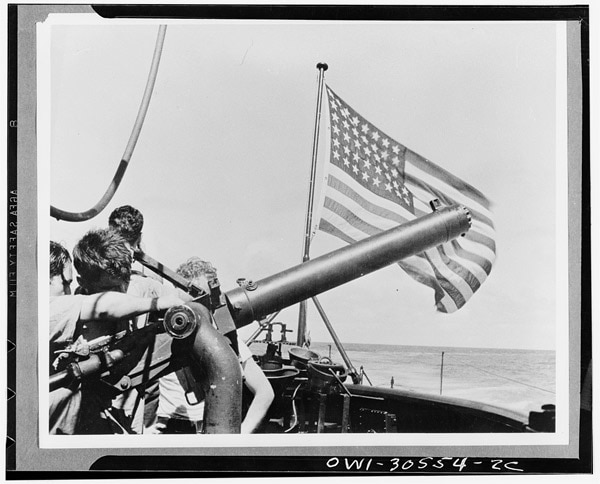
Watercooled fifty cal BMG src: guns.com
WW2 American Destroyers in Action
The role played by the fleet destroyers during the war was invaluable. Fast, heavily armed, with competent and agressive crews, they played their role to the full and fared well against their Japanese counterparts. Encounters with German destroyers has been rare in comparison, mostly on the dreadful northern route to Murmansk.
Most of the time, american destroyers played an escort role, for battleships and aircraft carriers. In some occasions, they were the only warships available to protect convoys or task forces. Such was the case with probably the most heroic feat by any destroyers in history, which happened during the gigantic battle of Leyte.
Kurita’s plan worked as his squadron evaded USN reconnaissance, whereas Halsey’s protecting fleet, lured out by a juicy Japanese fleet bait, was absent to defend the landings. What followed in substance was the last stand of three destroyer to defend Taffy three, a mix of assault ships and escort “jeep carriers” covering the amphibious operations at the opening of the Philippine campaign.
For hours, they stood against the might of the Japanese navy, and repelled it against all odds, but paid a heavy price for it. All three, USS Johnston (DD-557), Hoel and Samuel B. Roberts led a desperate, doomed but heroic resistance against Kurita’s naval squadron and added to the total battle honors and citation of crews from Fletcher-class DDs, certainly the mot battle-hardened and decorated class of destroyers in the USN history.
Cold War evolution
Fletcher DDE (1950)
Rather than creating a brand new class, the US Navy admiralty order the conversion of 18 existing Fletchers. The goal was both to improved their electronics and ASW armament and extend their lifespan by 20 more years, and also to be used as testing platforms for further modernization of more morern classes. When the program ended, the Soviet Navy indeed had not yet built its very large conventional submarine force.
The next Sumner and Gearing were of a completely new breed. Both adopted the new twin turrets and larger hull with low superstructures, two quintuple top-mounted TT banks and reloads while the emphasis was put on AA artillery and modern electronic, radar and sonar. The Sumner were also more massive at 2 610 tons standard and 3 218 t. fully loaded, much more than the 2800 tons of the previous Fletchers. However since there was no progress on their machinery, speed fell to 36 knots instead of 38.
The next Gearing class were an all-out improvements with a larger hull to accomodate more horsepower, in order to regain the two lost knots. This was paid by a heavier dispacement at 3 460 tons fully loaded. Built in the end of 1944, only 106 were completed as the president opposed his veto for further orders and there were dozens of cancellations. They assisted the task forces with a deadly AA barrage in the last operations of the war.
More so, the Sumner and Gearings stayed in service for a considerable part of the cold war.
Gearing DDE (1952)
They were nine incomplete ships completed as modern ASW escorts. The most extreme in that occurence was the USS Carpenter. These ships suvived well into the 1980s. They were given new DP automatic turrets, modernized twin 20 mm AA mounts, and the Alfa weapon ASW system, plus a conventional TT banks and DC track, modern radars and sonars.
Others were duly modernized with DDE features but were scrapped in the 1970s or exported.
Gearing FRAM I (1959-64)
This large scale modernization program was intended to overhaul all units in service so far with the latest equipments, radar and sonar, while keeping their original armament (at least the three twin turrets). But apart this, armament was often completely revised, with ASROC ASW system, DASH, and the new Mk32 ASW TT launchers.
The FRAM I was an extensive reconstruction program delivered to all existing Gearing class destroyers and destined to prolongate their lifespan to 10 more years at the least. This was also a cost-saving measure which allowed the USN to concentrate on less numerous modern classes of more costly missile destroyers. Only with the Spruance class of the 1970s, the USN get rid of these WW2 generation for good. They were also cheap and attractive on the export market, making their way into many navies for more years of service (in many cases past the end of the cold war !).
Sumner FRAM II (1961-66)
This modernization program was to prolongate initially the active life of these destroyers by five years. It was later made much more extensive. Apart the turrets which were kept, the superstructures and bridge were rebuilt, new radars and sonars adopted, a variable-depth sonar installed at the rear, Mk32 ASW TTs adopted, mk 15 hedgehog, Mk 37 TTs (fixed) instead of ASROC (the hull was too short to carry it), and a DASH drone. These ships were discarded (for those not exported) in the 1970s.
WW1 era American Destroyers
 Caldwell class destroyers (1916)
Caldwell class destroyers (1916)
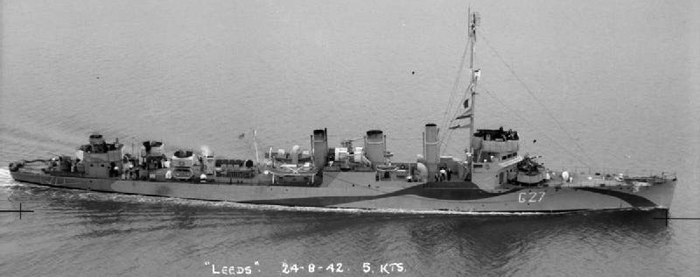
USS Leeds 1942
These 6 destroyers were in many ways the precursors of the Wickes and Clemson mass series, and they are often equated with Wickes. However, they are a bit of prototype series. Among the great differences that separate them from their ancestors, the Tucker, Cassin and Paulding classes, their continuous-deck hulls and their superstructure, their armament, proceeded from a new design intended for emergency constructions at the time when the USN was entering into the great war.
These ships, completed before the end of the conflict, had the privilege of being rare American destroyers who saw the two world wars. True veterans in 1941, they were relics, but remained perfectly operational thanks to the meticulous maintenance provided by their respective crews.
Their fate was quite different according to the ships of this class. If in September 1939 they were in pre-reserve, the Caldwell being erased lists in 1936, the Gwin was also demolished before the war, this year 1939. The USS Manley became an auxiliary in 1938, then a transport in 1940 (The first , APD1), the Craven, Conner and Stockton were transferred with 47 other destroyers to Britain in 1940. They survived the conflict and were scrapped in 1945-47.
But the oldest US destroyer was the USS Allen, dating back to 1916, a Tucker-class ship. He served as an auxiliary destroyer, in the second line, or even training, and was clearly distinguished by its very close chimneys and his short forecastle. Serving peacefully in territorial waters, it will be scrapped in 1946.
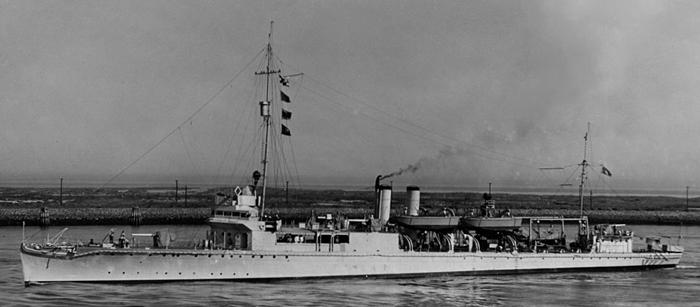
US Manley as APD-1 1940
Specs (As Escorts, 1942):
Displacement: 1,220 t. standard -1 360 t. Full Load
Dimensions: 95.7 m long, 11.3 m wide, 3.7 m draft
Machinery: 2 propellers, 2 Westinghouse turbines, 4 White-Forster boilers, 27,000 hp.
Maximum speed: 35 knots
Armament: 4 x 102 mm cannons, 4 x 12.7 mm AA, 12 TLT 533 mm (4 x 3)
Crew: 150
 WICKES/CLEMSON classes (1917-21)
WICKES/CLEMSON classes (1917-21)

USS Williamson, author’s illustration – AVP conversion march 1942
With a total production of 270 american destroyers, the Wickes / Clemson class (which differed only in minor details) was the largest numerically ever undertaken by any country. It responded to a concrete and urgent need, to restore, after the entry of the US war during the great war, the domination of the Atlantic against the peril of the U-Bootes.
Pragmatic, the admiralty only further simplified the “peace” design that had prevailed until then. Four stackers with their flush deck and perpetually spray-decked bridges became one of the most recognizable icons of the US Navy during the period from 1917 to 1936.
Subsequently, new classes were which made this design dating back to 1910, largely obsolete. In 1941, the US Navy still had 169 units in its ranks, most of them in reserve or kept for instruction. 13 had been lost during the First World War and another 93 were scrapped in 1931 under tonnage reductions imposed by the Washington Treaty.
Finally, 50 were donated to the Royal Navy under the Lend-Lease agreement, which was badly needed in the same circumstances. One of these old ships later served one of the most daring commando operations of the war, the raid against Saint Nazaire…
The remaining ships were therefore gradually restored, ie. rearmed with a much enhanced AA and ASW grenades, mortars, sonar and ranging equipment, and modern radios. Their artillery was often amputated to allow mounting this extra equipment and keep stability intact. In the end, all these ships were taken in hand for three major conversions:
– 19 AVP/AVD (from 1938): Squadron refuges, with tanks instead of some boilers (speed reduced to 21 knots), other facilities to receive mainly large quantities of fuel oil, and a reduced armament to 2 x 102 mm and 6 x 20 mm, 20 ASW grenades. They served mainly in the Pacific.
– 31 AG/AGP (6 from 1939, 25 in 1941-42): Rapid assault transports. They were used in the Pacific to carry Marine Battalions (144 men) with their equipment, fitted with gantry cranes for 4 LP/L-LCP/R landings and reserves. Armament: 5 x 76 mm, 2 x 40, 5 x 20 mm, plus 1x 10 stern DCR and 4 DCTs.
– 26 DM/DMS (8 in 1939 followed by 18 in 1941-43): Fast minesweepers with reinforced weaponry of 6 x 20 mm and ASW grenades.

USS DuPont as escort in 1943 (destroyerhistory.org). The typical three-tone camouflage of the late 1943 to early 1944 consisted of medium blue, black and light gray, applied in broken lines. Some of these escorts were practically “left in their own juice”, with their four boilers, unchanged speed and four 102 mm main artillery.

The USS Barney (AVP conversion) in December 1942, Guadalcanal. These assault ships deployed in the Pacific received camouflage liveries specific to their environment. They were called the “green dragons” Read more >
Remainder units were taken in hand for modifications including the addition of a modern AA, and replacement of some of their older A guns by modern 76 mm, and numerous ASW grenades (70-80) in racks in the stern plus four side DCT mortars.
To increase their range, their coal-fired boilers were replaced by oil-fired models, the space saved used to build tanks for a better range, while their top speed was increased to 24 knots (31 at the origin) (See specifications).
It was this type of american destroyers that played a vital role, before the new dedicated escorts arrived, to track down U-Boats in the Atlantic. Overall losses were 32 ships, including those of the British. The most famous was the USS Reuben James in March 1941, mistakenly torpedoed by an overzealous U-Boote, before the US were at war. But unlike the blunder of “Lusitania” in 1916, this loss passed almost unnoticed in public opinion, still too fiercely neutral. The admiralty, on the other hand, no longer specified any restriction on the sight of a periscope and USN destroyers fired at will.
Characteristics (Escort variant, 1942)
Displacement & Dimensions: 1250 t, 1380 T PC, 95.7 x 11.3 x 3.7 m
Propulsion: 2 propellers, 2 Westinghouse turbines, 4 White Forster boilers, 27,000 hp. and 35 knots max.
Armament: 4 x 102 mm (or 76 mm) guns, 6 AA 20 mm Oerlikon, 2×3 TT 533 mm, 20 ASW grenades, 4 ASW mortars.
Crew: 150 officers and sailors.
Interwar American destroyers
 Farragut class (1934)
Farragut class (1934)

USS Farragut, author’s illustration – Atlantic neutrality patrols 1940
The Farragut were the first American destroyers built since the end of the “four pipers” in the early twenties, following the Treaty of London. Engineers responsible for drawing the blueprints had all the time (nearly 14 years) to see the evolution of Japanese and European designs and arrived with a type of ship then at the forefront of naval innovation for destroyers.
Not having the need for mass production, they had a forecastle, more rational in terms of interior fittings. Artillery was also remodelled, centerline with a new type of telemeter and new fast-firing 127 mm Mk12 38 caliber naval guns, the standard to come for 60+ years.
They also had a wider hull, better balanced and more stable, with anti-roll keels. Finally, torpedo-tubes, quintuple, were now placed in the axis rather than a four triple banks on the sides. With more available power despite their tonnage, their test speed was around 38-39 knots, but their official limit was 37.
These eight ships were much more expensive to produce than the Clemsons, but their performances on the high seas were way above, and sailors which served in those ships were particularly envied. The fact remains that the following classes took charge of replacing the old flush-deckers at the rate of nearly four per year.
The Farragut were launched in 1935-36 and operational in 1936-37. They served until 1945, receiving a new AA weaponry with 40 mm twin and single 20 mm Oerlikon rifles, as well as ASW grenades at the stern and sonar.
All were present at Pearl Harbor, but none was seriously affected during the attack. Strangely none was sunk during the war but only by natural causes: The USS Worden was stranded on a reef in Alaska, and the USS Hull and Monaghan were lost during a typhoon in the Pacific in 1944.
Specs 1942:
Displacement & Dimensions: 1358 t, 2064 T PC, 103.9 x 10.4 x 3.5 m
Propulsion: 2 propellers, 2 Curtis turbines, 4 Yarrow boilers, 42,800 hp. and 37 knots max.
Crew: 160
Armament: 5 x 127 mm, 2 x 2 40 mm Bofors, 4 x 20 mm Oerlikon, 2×4 TT 533 mm, 20 ASW grenades.
 Porter class (1935)
Porter class (1935)

USS Porter, author’s illustration – Atlantic neutrality patrols 1940

USS Selfridge 1944, author’s illustration
The Farragut-derived Porter Class was a new destroyer model analysed at the time as belonging to the “Flotilla Leaders” category. This was an interpretation of the Washington Treaty squadron leaders defined as having Treaty-restricted standard displacement, confirmed by the London treaty to 1850 tons. They were powerful destroyers destined to lead a group of “standard” destroyers (1,500 tons and below).
In fact the Porter class was especially designed to take the head of flotillas of “flush-deckers” still in service. This category was also known for a long time by the British, the French and Italians. The Germans and Japanese on their side only developed heavy destroyers right from the start instead of the weaker Western “standard” types, like the Z1 and Fubuki.
In this category, these American ships gave in a relative excess. With a displacement of 2500 tons fully loaded ( to respect the treaty’s standard limits), they managed to implement no less than eight 5in guns (127 mm) guns with four twin turrets, a configuration also retained by British destroyers of the Tribal class in 1936. This considerable top-weight was a real headache for the engineers to balance and was not even solved by ballasting the wider hull and counter-keels.
Indeed this heavy artillery was condemned to serve only as AA defense since the ships rolled badly in all weather conditions. These stability issues were solved for good in 1943-44, as the four ships of this class (USS Selfridge, USS McDougall, USS Winslow, and USS Phelps) went to drydock for a complete overhaul (See second illustration).
At the end of this modernization, their armament was now made of the new standard twin 5-in semi-automated turrets, and a powerful AA. Superstructures were lowered and reduced. These american destroyers also had modern warfare equipment such as sonar, radar, and ASW grenades supplemented with grenade throwers, and a 40 mm mortar at the stern.
The USS Selfridge, which kept her original weaponry until 1944, received five 127 mm in two twin turrets and one single, three twin 40 mm and one quadruple Bofors AA, and six Oerlikon 20 mm AA guns. The USS Porter, the only loss of this class, was sunk at Guadalcanal in October 1942.
Specifications: (1940):
Displacement: 1,834 t. standard -2,597 t. Full Load
Dimensions: 116.5 m long, 11.3 m wide, 3.96 m draft
Machinery: 2 shaft Curtis turbines, 4 B&W boilers, 50,000 hp.
Top speed: 37 knots
Armament: 8 x 127 mm (4×2), 8 x 40 mm (2×4) AA, 8 TT 533 mm (2×4)
Crew: 194
 Mahan class (1935)
Mahan class (1935)

USS Perkins in 1943, author’s illustration
The 18 ships of the Mahan class were repeats of the standard Farragut class, but built in a larger scale. They were defined in 1933, laid down in 1935 and launched in 1935-36. Among the improvements were new, smaller boilers providing additional space for AA defence, an additional torpedo tubes banks and refills for these tubes.
The trick was to place two of these banks laterally and not in line. They met a specification aimed at creating units tailored for the Pacific, and able to meet Japanese destroyers of the Fubuki class and following.
The hull and tonnage on the other hand, were unchanged, and these ships barely respected authorized tonnages, and lacked stability as well as showed a fragile construction.
Two of these american destroyers, the USS Cassin and the USS Downes, were sunk at Pearl Harbor on December 7, 1941. The others were sunk during the violent engagements of 1942-43, and by that date the survivors had been modified in order to keep only two TT banks, four 5-in guns, reduced superstructure, radar and sonar, ASW grenades and four 40 mm AA (twin mounts) and five Oerlikon 20 mm AA.
They paid a heavy tribute to the war, with 6 units sunk, including the USS Mahan, Reid, Tucker, Cushing, Perkins, and Preston. The Cassin and Downes were recovered and their equipment, weaponry and machinery were reintegrated into new supernumerary hulls. They were back into service at the end of 1943 with the new “admiralty” low superstructures with portholes, and their two TT banks in the axis. The other unchanged vessels were still criticized for their excessive roll, and as a measure their TT banks were most often removed in favor of AAA.
Specifications
Displacement: 1,488 t. standard -2 103 t. Full Load
Dimensions 104 m x 10.6 m x 3.76 m draught
Machinery: 2 propellers, 2 GE turbines, 4 B & W boilers, 49,000 hp.
Top speed: 36.5 knots
Armament: 5 x 5-in (127 mm guns), 4 x 05 in (12.7 mm) AA, 12 x 533 mm TTs (3 x 4)
Crew: 158
 Gridley/Bagley class (1936)
Gridley/Bagley class (1936)

USS Craven in 1944, author’s illustration
These two series of american destroyers(4 Gridley in 1936-38 and 8 Bagley in 1936-37), proceeded of the same design aiming to produce destroyers more stable, but also faster and better armed. As such, the Gridley built by Bethlehem Steel were more hydrodynamic and achieved good results. Their main armament was reduced to a 127 mm gun, and if as usual their rear parts were devoid of any protection (against the spray more than against the enemy fire), the front parts yielded their shields for completely closed turrets .
On the other hand their armament in torpedoes was pushed to its extremes with this time not less than four banks of tubes placed on the deck in lateral pairs. There were no more refills, but the stability was strengthened. On paper, this represented only a side-lining of 8 torpedoes, which was not unusual, but in exercise commanders using the best torpedoes with programmed guidance in curved trajectory managed to hit their targets by letting go their 16 torpedoes at the same time.
This formidable armament proved to be valuable in combat, especially to face the ferocity of Japanese tactics in Guadalcanal. From 1942, the Gridley received only 20mm guns as reinforcement. They all survived the conflict. The 8 Bagley on their side were a little bigger (one meter in length, 20 cm in width), heavier than 50 tons, but had the same armament.
In 1945, however, the 4 Gridley were returned to the Atlantic and lost two of their tube banks, while the Bagley’s DCA was increased to two 40mm guns and six 20mm AA guns. A modernization program in 1945 provided for all of their tube benches to be removed with the installation instead of no less than two quadruple and two 40 mm (12 in total) and four 20 mm double carriage carriages. plan was stillborn. The Bagley recorded three losses in action, the USS Blue (August 22, 1942), Jarvis (August 9, 1942) and Henley (October 3, 1943).
Specifications in 1942
Displacement 1,590 t. standard -2,219 t. Full Load
Dimensions 103.9 m long, 10.6 m wide, 3.9 m draft
Propulsion 2 shafts Bethlehem turbines, 4 Yarrow boilers, 50,000 hp.
Top speed 38.5 knots
Armament 4 x 127 mm cannons, 4 ML of 12.7 mm AA, 16 TLT 533 mm (4 x 4)
Crew 158
 ^
^
 Somers class (1937)
Somers class (1937)

USS Davis in 1944, author’s illustration
The 5 Somers were the same series of “flotilla leader” as the Porter of 1935-36. They were heavily armed american destroyers, but they distinguished from the first serie by their unique funnel and their three TT banks (with two side banks).
They moved 150 tons more, but they were not faster. They were very prone to roll, and in 1942 it was decided to remove their upper TT banks and rear superfiring twin turret in favor of light AA.
The USS Davis and Jouett were the only ones rebuilt in 1944, such as the Porter class, with a new Admiralty-type gangway, two double turrets and a 127 mm single, and fourteen 40 mm guns in one twin and three quadruple mounts, plus four 20 mm Oerlikon in twin mounts. The USS Warrington was the only one lost in September 1944.
Specs (escort, 1942):
Displacement: 2,047 t. standard -2,767 t. Full Load
Dimensions: 116.13 m long, 11.25 m wide, 3.8 m draft
Machinery: 2 propellers, 2 GE turbines, 4 B & W boilers, 52,000 hp.
Top speed: 37 knots
Armament: 8 x 127mm, 8 x 40mm AA (2 x 4), 12 TLT 533mm (3 x 4) guns
Crew: 294
 Sims class (1938)
Sims class (1938)

USS Sims in 1942, author’s illustration
The 12 destroyers of the Sims class were the continuation of the Mahan, but with many differences: They marked a new standard, away from the mistakes of the previous Gridley-Bagley-Benham.
In 1937, when their genesis began, the second treaty of London was ratified, which noted the limitations of tonnage in global tonnage, with a revalued ceiling at 3000 tons. The Sims were thus established on this basis.
In particular, it was to leave the theoretical system that had prevailed so far to better take into account the critics and wishes of the destroyers commanders. They were larger and heavier, but not far removed from the 1930 standards (1500 tons), still posing stability problems that were only solved at the cost of many plans and modifications advocated by the new Bureau of Ship and Repair.
The latter replaced in 1940 the two competing organizations between which the communication went badly, the Bureau of Construction and Repair and the Bureau of Engineering. The Bureau of Ordnance took care of its side of the armor, guns and carriages.
Planned for the Pacific, the 5th 5 in (127 mm) gun was kept but the banks of raised tubes were sacrificed to return to two benches in line on the deckhouse. Although loading the ship in the highs, these tubes were put out of the spray.
In addition, they owned their parts in closed turrets and a single chimney. Finally, shortly after the beginning of hostilities, two ASW grenades racks were added to the rear. Revised by the new organization, they also received the new rangefinder Mk 37 assisted by “computer” (a large calculator with diodes and cards) installed in a dedicated room of the bridge.
In 1941, they all served in the Atlantic and therefore landed their turret No. 3 (rear) in favor of a gun ASM Y-Gun, while they received radar, sonar and ASM grenades. In 1943, they all received two 40 mm double carriages and four 20 mm AA carriages. And three of them had in 1945, 8 guns of 40 mm and 8 of 20 mm AA, all doubles.
In many ways, the Sims were the draft of the next Clemson / Gleaves built in mass. They gave full satisfaction during the war although 5 units were lost on fire: The USS Sims, Hamann and O’Brien, Walke in 1942, and the USS Buck in 1943.
Characteristics (escort, 1942):
Displacement: 1,764 t. standard -2 313 t. Full Load
Dimensions: 106.17 m long, 10.97 m wide, 3.9 m draft
Propulsion: 2 shaft Westinghouse turbines, 4 B & W boilers, 50,000 hp.
Top speed: 35 knots
Armament: 8 x 127 mm, 4 ML 12.7 mm AA, 8 TLT 533 mm (2 x 4)
Crew: 192
 Benham class (1939)
Benham class (1939)
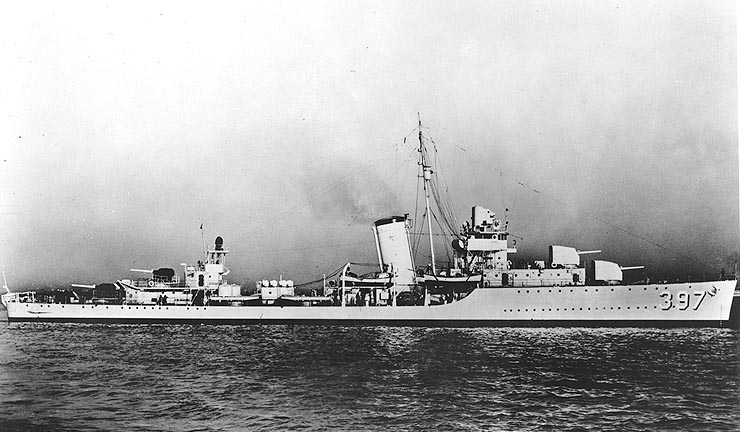
USS Benham, DD-397 in 1939
Inspired by the previous Gridley and Benham but differing essentially by their unique funnel and their four 127 mm parts of a new semi-automatic closed turret model, which will be repeated in the following series, and will experience a service under many other pavilions, until 1970.
The other striking feature were their four quadruple tubes benches side, only launched by “lined”. Their stability was not compromised, however, but they were heavier than previous series. One of their boilers was removed in favor of additional space for oil reserves.
In 1940 they were engaged in the escort of convoys on the west side of the Atlantic, and re-equipped with grenade pots, side ASW mortars, an ASW gun replacing their two benches of rear tubes, and they were equipped with a sonar station and light AA.
Four units were transferred to the Pacific, receiving in 1943 four 40 mm guns and four 20 mm Oerlikon guns, then four 40 mm and eight 20 mm, their remaining tubes bank being deposited. USS Benham and Rowan were sunk in November 1942 and September 1943, respectively.
Characteristics
Displacement: 1657 t, 2250 T PC
Dimensions: 103.9 x 10.8 x 3.9 m
Propulsion: 2 propellers, 2 Westinghouse turbines, 4 White B & W boilers, 50,000 hp
Top speed: 38.5 knots max.
Crew: 184
Armament: 4 x 127mm guns, 4 x 12.7mm AA, 2 x 2 40mm, 4 x 20mm, 4×4 TT 533mm, 20 DC, 4 DCT.
WW2 USN Destroyers
 Benson class (1939)
Benson class (1939)
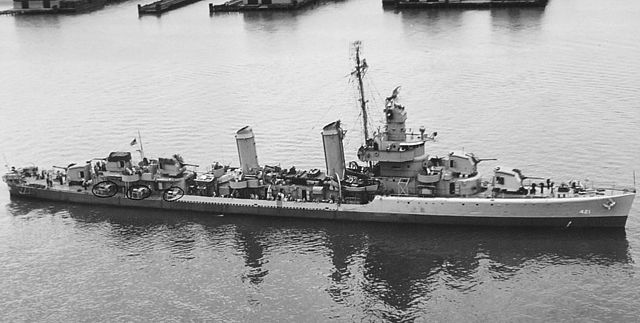
USS Benson (DD-421) circa 1942.
These thirteen ships were the last USN destroyers designed and built prewar. Their basic design was ready indeed in 1938 when their keels were laid down, and the first, USS Benson, which gave its name to the whole serie, was launched in November 1939, just a month and 11 days after the invasion of Poland. The Bensons were also the first to escape the mass scrapping wave postwar. They were closely derived from the Sims, but with a new boiler arrangement, with four smaller boilers instead of three, and placed in échelon to save space. They shown this by having two funnels instead of one, and were the first to adopt quintuple torpedo banks, on the centerline fore and aft of the rear funnel on the superstructure.
Although officially still 1620 tons destroyers, the Benson class was far heavier, reaching 1840 tons standard and up to 2395 tons fully loaded. USS Benson was built in Bethlehem, Quincy, and Gleaves (DD 423, 9 December 1939) at Bath Iron Works. Other yards implied into the effort were Puget Sound, Federal -Kearny, Boston NyD, Charleston NyD, Seattle-Tacoma, and later Staten I yard, freshly built at Bethlehem and another at San Francisco, and San Pedro.
Characteristics – As design (1939)
Displacement: 1839 t, 2395 T FL
Dimensions: 106.17oa x 11.1 x 4 m
Propulsion: 2 shafts Westinghouse turbines, 4 B&W boilers, 50,000 hp.
Top speed: 35 knots max.
Crew: 208
Armament: 5×5 in /38 (127mm), 10 x 0.5-in AA, 2×5 TT 21-in (533 mm), see notes.
 Gleaves class (1939)
Gleaves class (1939)
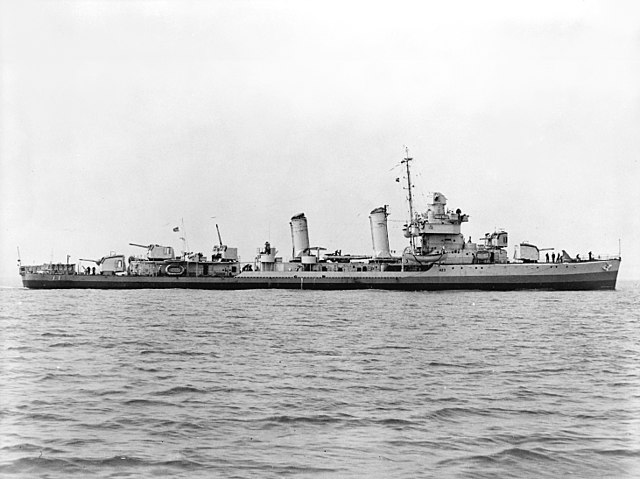
The sixty-six Gleaves were built in parallel, and were ten tons heavier but only differed by minor details, yard-based. Distinction between the two classes is rather superficial, as they were virtually identical, only differing by weight and the Benson having flat-sided funnels, whereas they were round on the Gleaves.
They were the last USN destroyers built with a forecastle (no flush deck), but in essence, had the genes of the following Fletchers. They had the same armament of five 5-in/38, six single 0.5 in (12.7 mm) AA HMGs Browning of the liquid-cooled types, and two quintuple TT banks with slightly differing ASW armament.
Production for both classes went on until February 1943 when the USS Thorn and Turner (DD 647, 648) were launched. Most authors and Conways mixed the two classes into one in fact. However a major difference came with the Bristols, from DD 453 onwards, which tended to sacrifice the antiship capability for reinforced AA and ASW capabilities. The biggest difference was the adoption of a more potent and modern AA artillery, sacrificing a turret and TT bank in the process.
The Benson/Gleaves had indeed a subclass known as the Bristol (DD 453) class, 48 ships in all, which were wartime-designed and had four 5-in guns as ordered, four 40 mm AA in twin mounts, seven 20 mm AA and just one TT bank, plus 4 to 6 DC throwers and two DC racks at the stern.
Twenty-one of these Gleaves & Bristol subclass class were in commission when the Japanese attacked Pearl Harbor. Of course afterwards, production was step up and the logical step was to deliver the simplified Fletchers. But in 1941 already, the admiralty ordered simplifications in design to Seattle-Tacoma batch (DD493-497, 624-628) and Federal/Kearny (DD618-623, 645-648) with squred-faced bridges and directors directly on the pilot house rather than suspended on pedestals. After these changes, USS Livermore was tested at 50,400 hp and 37.58 knots at full speed.
In total, sixteen of both class were sunk in action, starting with the USS Meredith (15.10.1940) the USS Lansdale (20.4.1944), Gwin (13.7.1943), Monssen (13.11.1942), Ingraham (22.8.1942), Bristol (12.10.1943), Emmons (06.04.1945), Laffey (13.11.1942), Corry (6.6.1944), Hobson (27.4.42), Aaron Ward (7.4.43), Duncan (12.10.42), Glennon (10.6.44), Maddow (10.7.43), Beatty (6.11.43) and Turner (3.1.44).
 Fletcher class (1941)
Fletcher class (1941)

USS Fletcher in august 1942 (http://www.history.navy.mil/etchers)
The Fletcher embodies all the military-industrial power of the United States. This was the first class of the mass-produced war, and the largest, with no less than 175 units launched until 1943.
Again, we took the hull flush deck directly inspired by the previous Benson/Gleaves, and all Construction details were reviewed for maximum production ease.
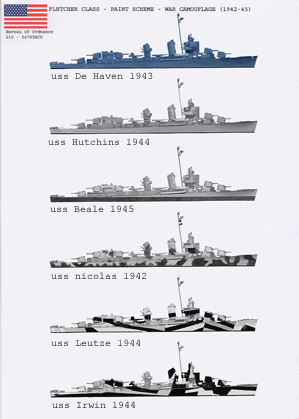 Unlike the previous class, however, an additional lookout for these 127 mm semi-automated parts was added, mainly to meet the better armed Japanese destroyers. In fact, the Fletcher was launched in May 1942, the last in September 1944, most of the following units were assigned to the Pacific.
Unlike the previous class, however, an additional lookout for these 127 mm semi-automated parts was added, mainly to meet the better armed Japanese destroyers. In fact, the Fletcher was launched in May 1942, the last in September 1944, most of the following units were assigned to the Pacific.
Their tonnage was the largest in the US Navy for a destroyer with nearly 3000 tons at full load. All were equipped with the latest detection equipment, ASDIC-SONAR and radar, with modern fire control lines and a sophisticated central operation. Their AA artillery was not forgotten, and included the new 40 mm trolleys in tubs reinforced with individual Oerlikon pieces.
With 127 mm AA firefighting capabilities, it was a triple layer of protection around every Fletcher. The anti-ship armament consisted of two quadruple axial banks with refills. The latter would play a crucial role during the Battle of Leyte.
During the conflict, the experiment made replace on the series in court, the initial footbridge, too exposed, by a model had “low bridge”. Additional adjustments were made for the crews, and additional DCA was gradually added, leaving one of the TLT benches to be removed.
Their detection equipment was also improved, along with their AA fire lines. Their career is of course long and their charts impressive, given the number of their quotes for war. They were the most decorated american destroyers. They were gradually replaced by the new generation of 127mm double-hulled destroyers,
Allen M. Sumner and Gearing, and served, with modernization, until the beginning of the Vietnam War before join the scrap metal.

Characteristics (1942)
Displacement: 2325 t, 2942 T FL
Dimensions: 114.7 x 12.1 x 4.2 m
Propulsion: 2 shafts General Electric turbines, 4 B&W boilers, 60,000 hp.
Top speed: 38 knots max.
Crew: 273
Armament: 5 x 127mm, 4 x 40mm AA, 4 x 20mm Oerlikon, 2×5 TT 533mm, 20 DC, 4 DCT.
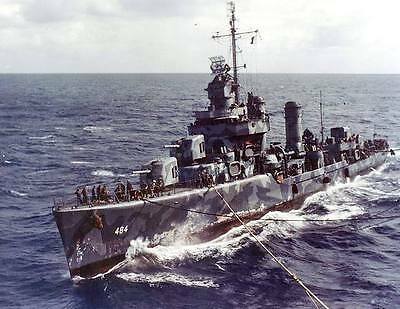
 Allen M Sumner class (1943)
Allen M Sumner class (1943)

USS Sumner in 1943 showing the admiralty bridge, author’s illustration
The Sumner were the second-to-last American destroyers of the conflict. But above all they marked a break with the Fletcher: they announced the following Gearing, seemingly consistent copies of the first.
Compared to the Fletcher, they had three standard two-tube turrets of 127 mm, an increase of a barrel compared to the previous class. Their DCA was much better, with a slightly enlarged and deeper hull, for 300 tons more. The project dated from a 1941 Admiralty Specification, which advocated a new design based on standard double turrets, which freed up space for additional AA.
Also in 1942, the Admiralty had begun research on a new 2500 ton high speed destroyer. The project required machines far superior to those of the Fletcher, so they were not ready in time to meet the first specification. So we started to produce a class of “interim”, and it was the Sumner.
As a result they used the same hull and the same machines as the Fletcher. This increase in movement resulted in a loss of speed, which rose to 36.5 knots instead of 38.
It was the crews and unit commanders who had claimed since 1942 a drastic increase in firepower, but all this DCA posed additional weight problems that were only solved in 1945 with the Gearing.
The first Sumner series (58 units in total), also had a gateway “admiralty” closed and no open bridge, which discouraged the first commanders, demanding visibility. From the units completed in early 1944, the gangways had given way to a new closed and open-deck model.
The 58 Sumner-class ships were overall satisfactory in service. They had the opportunity to distinguish themselves although the last ones were only launched at the end of 1944 and completed at the beginning of 1945. 12 ships were completed as minelayers, but gave little satisfaction in this role and were converted back as radar pickets.
Four of them, present in Okinawa, were badly damaged by Kamikazes. Despite their commitments, there were only 3 casualties in combat: USS Cooper, Mannert E Abele, and Drexler.
Characteristics (Escorts, 1942)
Displacement: 2,610 t. standard -3 218 t. Full Load
Dimensions: 114.7 m long, 12.45 m wide, 4.32 m draft
Machinery: 2 shaft GE turbines, 4 Babcock & Wilcox boilers, 60,000 hp.
Top speed: 38 knots
Armor: 12.7 mm machine bridge, 19 mm belt
Armament: 6 x 127 (3 × 2), 12 x 40 (2 × 4, 2 × 2), 11 x 20 AA, 10 x 533 mm TTs (2 x 5), 4 DC, 2 DCT
Crew: 336
 Gearing class (1944)
Gearing class (1944)

Appearance of the Gearing class in January 1945 (entry into service), author’s illustration
The Gearings were the last American destroyers of the war. They preceded both the Sumner specifications for armament, with a new, larger hull to house new turbines to regain the speed lost with previous ships.
Even if the minimum power remained the same, 60,000 hp, they gained three tenths of knots in speed, because if the hull was on the other hand of the same width, the length allowed to improve the flow and the hydrodynamic penetration. This hull length also improved the capacity of oil tanks and thus autonomy.
The initial mass program included 116 units, and 36 better ones to which the president vetoed. In the end, 106 were really finished, including about twenty too late to participate in the conflict. A high-speed prototype with 100,000 hp turbines was built with a lighter hull, but it was disappointing.
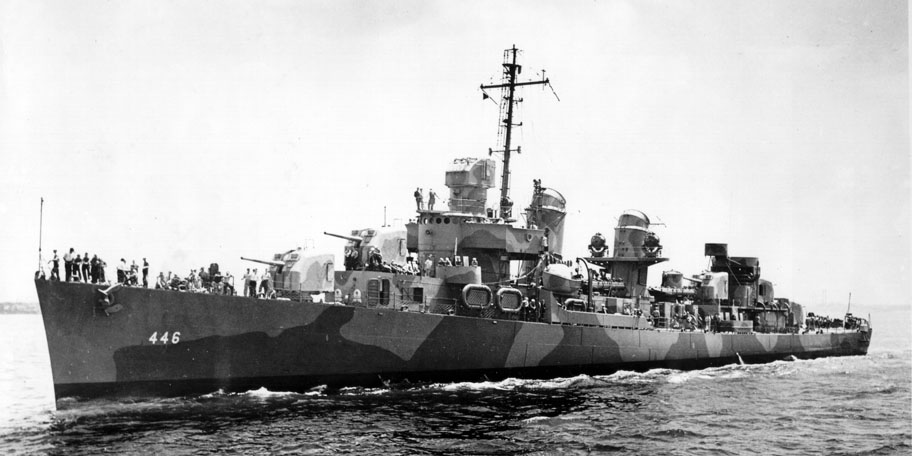
Federal Shipbuilding & Dry Dock Co.
Kearny, NJ
Commissioned in 1945, these ships had little opportunity to confront Nippon surface units, but effectively assisted the Task Forces during the last major operations thanks to their DCA. 12 units were converted under Admiral King in January 1945 as radar stakes.
After the war, the Gearings were the backbone of the US Navy’s destroyers until the 1960s. They were reconverted and modernized (FRAM), and many of them were still in reserve in 1980. More than three quarters were by elsewhere sold to many countries and some are still in use at the time of writing. A beautiful longevity for a ship built in the urgency.
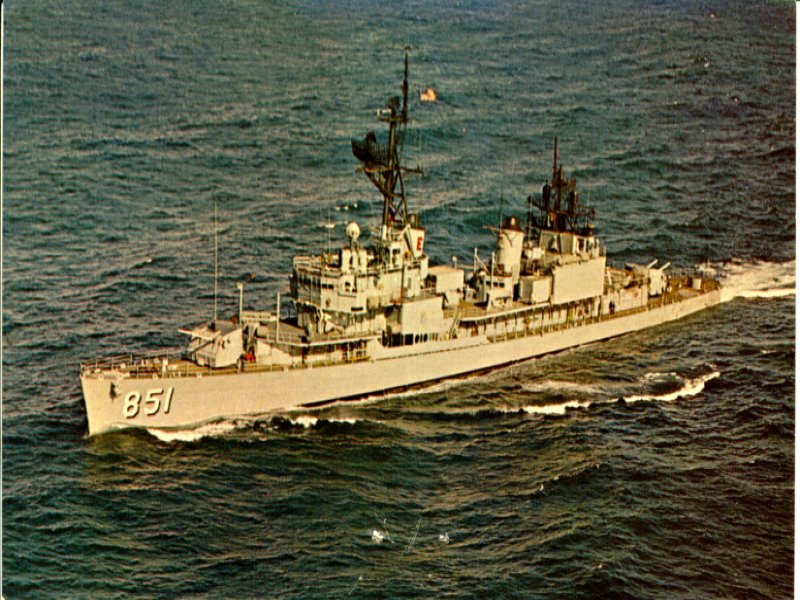

USS Chevalier – Gearing class blueprints
Characteristics (1945)
Displacement: 2,616 t. standard -3,460 t. Full Load
Dimensions: 119 m long, 12.45 m wide, 4.37 m draft
Machinery: 2 shaft GE turbines, 4 Babcock & Wilcox boilers, 60,000 hp.
Top speed: 38 knots
Armor: 12.7 mm machine bridge, 19 mm belt
Armament: 6 x 127 mm (3×2), 12 x 40 mm (2×4, 2×2), 11 x 20 mm AA, 10 x 533 mm TTs (2×5)
Crew: 336
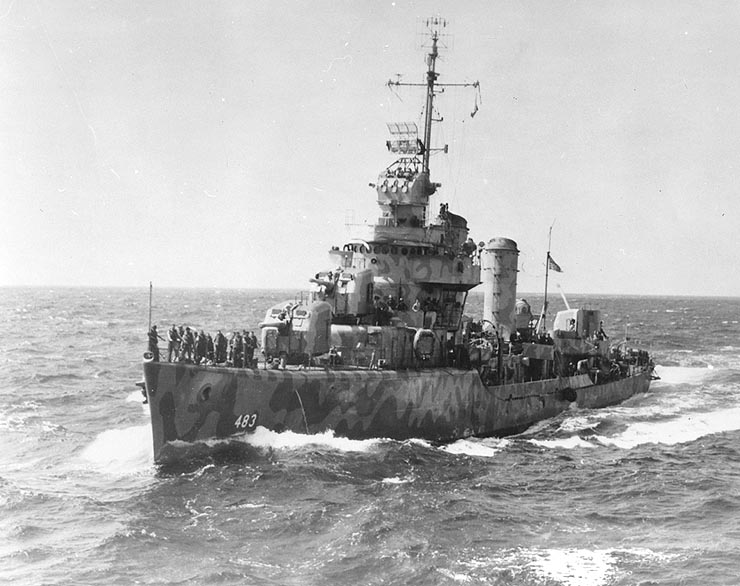
WW2 escort Destroyers
 DET/FMR (1942)
DET/FMR (1942)

USS Edsall (Type FMR, DE129) in 1944
The DET (Diesel Electric Turbines) and FMR (Ferbanks Morse Reduce), also called Cannon and Edsall class were the most emblematic DE American, and ultimate experiments in thrusters. The class “Cannon” later designated all 350 Escort Destroyers built by the US during the war.
The former had large General Motors turbo-electric turbines, similar to those of the fleet’s submersibles, and the diesel FMRs, all for reduced speeds. By cons, they had 4 pieces of 76 mm instead of 3 on GMT, or TE.
A total of 149 units were produced until August 1944, but the FMRs were started in 1942 (the USS Edsall launched in November), and then completed in 1943 and early 1944.
They also helped to save Atlantic convoys and allow landings and supplies for US troops during the campaign in Europe. However, while the vast majority of these ships were resold to many countries after the war, the survivors were demolished in the late 1960s and early 1970s.
During the conflict, however, 6 were transferred to Brazil in 1944-45, and if no DET was sunk, four FMR were victims of the German torpedoes a priori because two were missing without leaving traces. These were USS Leopold and Holder, lost in 1944, the other two being USS Fiske and Frederick Davis.
Characteristics
Displacement: 1,253 t. standard -1 602 t. Full Load
Dimensions: 93.27 m long, 11.15 m wide, 3.20 m draft
Propulsions: 2 propellers, 2 electric diesel turbines, 6,000 hp.
Top speed: 21 knots
Armament: 4 x 76, 4 x 40 mm (1×4), 8 x 20 mm guns, 3 x 533 mm TTs, 2 DCT, 2 × 10 DCT
Crew: 186
 GMT/EVARTS (1943)
GMT/EVARTS (1943)
The DE (Escort Destroyers) of the GMT class (General Motors Tandem), are also called “short hulls”. They adapt unlike the other DE diesels walking in tandem with turboelectric devices, and lacking power they were quite slow even for american escort destroyers standards.
They were the first American escort destroyers, designed for a quick shipment of 50 escorts to the Royal Navy. (Captain class) Finally, the other 1005 planned for the program were partially canceled in September 1943, and while dozens of ships were taken back for conversion (transport, radar picket…)
GMTs were therefore 68 of the 105 ships scheduled to enter service. The first of these was the USS Evarts, launched in December 1942 and operational a few months later.
They had standard 76mm AA and AN guns, a hedgehog rocket launcher common to all US DEs, 4 bofors and 9 Oerikons 20mm guns, but no torpedo tubes. They also had ASM grenades with mortars, sonar and radar, with a system similar to the British Huff-Duff, and a high bridge with good visibility.
None of the units that came out between 1943 and 1944 were sunk in combat, and after serving in the Atlantic, they were disarmed and demolished as early as 1946, unlike other larger DEs. Their years of service were therefore more than reduced …
Characteristics
Displacement: 1,192 t. standard -1 416 t. Full Load
Dimensions: 88.22 m long, 10.72 m wide, 3 m draft
Propulsion: 2 propellers, 2 word. GM diesel, 6,000 hp.
Top speed: 19.5 knots
Armament: 3 x 76 mm, 4 x 40 mm (1×4), 8 x 20 mm, 1 ASWRL, 2 DCTh, 2×10 DCTr
Crew: 156
 TE Class (1943)
TE Class (1943)

USS Harmon, DE678 (released on 25/7/1943). Painted with the triple gradiant livery masure ?? livery at the beginning of 1945. Two typical shades of gray.
The ASW rocket heads of the “Hedgehog” can be seen from the front. However, the TE carries a variation of the armament practiced in 1944-45, with two 5 in (127 mm) in standard simple mounts, 3 quadruple Bofors 40 mm, and 12 single Oerlikons 20 mm.
The TE Class Escort Destroyers were larger and heavier than the 1942 “GMTs.” The “TE” for Turbine Engine, consistent with standard destroyers, was faster (23 knots instead of 21 knots).
As a result, they were not condemned solely to the escort but could, if necessary, serve with Task Forces, although this is not their vocation. The real playground for these units was the Atlantic and the U-Bootes hunt. These “long hulls” could carry a larger armament and adopted an AA defense revised upward.
But for the most part, these units kept the GMT 76 mm guns, two at the front and one at the rear, and had a single 40 mm quadruple rear fender and 8 mm 20 mm fender. a bench of triple torpedo tubes. Their ASM range, in addition to the Hedgehog rocket launcher at the front, included 8 ASM launch mortars at the stern, and two “racks” of 10 additional stern loads.
The first of the series, the USS Buckey (DE51) was launched at Bethlehem Steel on January 9, 1943 and the last on December 18 at Consolidated. 102 will be built, and modified in 1944-45 in their armament, losing their bench of torpedo tubes to make room for additional 40 mm carriages, and others their guns of 76 mm against 127 mm in turrets.
There were only three casualties during the conflict. the most famous of all American DEs, the USS England, was part of this class, and had a memorable hunting chart.
Characteristics
Displacement: 1,432 t. standard -1 823 t. Full Load
Dimensions: 93.27 m long, 11.3 m wide, 3.4 m draft
Propulsion: 2 shaft GE turbines, 6 boilers, 12,000 hp.
Top speed: 23 knots
Armament: 3 x 76, 4 x 40 mm (1 × 4), 8 x 20 mm, 1 × 3 533 mm TTs, 1 LR ASW, 8 DC and 2 × 10 DCT
Crew: 186
 WGT/TEV (1943)
WGT/TEV (1943)
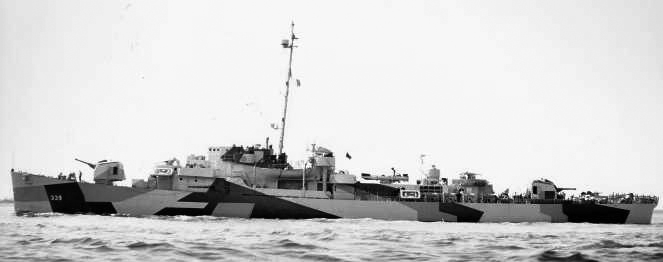
USS John C Butler, WGT type
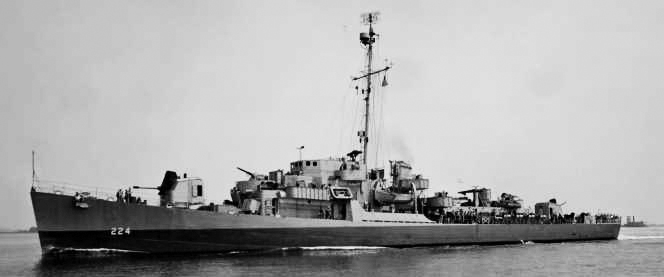
USS Rudderow – TEV type
The TEV (Turbine Engine, “V” for “5”, 5 inches) or Rudderow classes are “long hulls”, like all other US DE hull flush-deck except the GTMs. The “V” was the adaptation of 2 5-inch guns in semi-automatic turrets, ie 127 mm standard. The WGT, or John C Butler class, had the same hull and lower superstructures, and had Westinghouse gas turbine propulsion (Westinghouse Gas Turbines).
This superior firepower gave them better results against U-Bootes on the surface than the smaller 76mm. 105 ships, TEV and WGT combined were built, the last launched in August 1944. Several were lost in the Atlantic, torpedoed by submersibles. These were USS Oberrender, Eversole, Shelton, and Samuel P. Roberts.
Some were reused at the beginning of the Cold War, others sold, and most ended their career in the 1970s.
Characteristics
Displacement: 1,430 t. standard -1 811 t. Full Load
Dimensions: 93.27 m long, 11.28 m wide, 3.40 m draft
Machinery: 2 propellers, 2 gas turbines, 12,000 hp.
Top speed: 23 knots
Armament: 2 x 127mm, 4 x 40 mm (1×4), 8 x 20 mm AA, 3 x 533 mm TTs, 1 ASWRL, 2 DCTh, 2×10 DCTr
Crew: 156
Read More:
http://www.fr.naval-encyclopedia.com/2e-guerre-mondiale/us-navy-2egm.php#dest
Google Books – US Destroyers 1942–45: Wartime classes
De Dave McComb
Plans:
http://www.frosthistorical.com/destroyer.html
https://www.dd-692.com/shipyard.htm
https://floatingdrydock.com/TFW2.htm
Plans and visual resources
On destroyerhistory.org
HD cutaway pic of the Gearing
On dd-692.com – shipyard
3D corner
//sketchfab.com/3d-models/fletcher-class-destroyer-2d2311ba7c8144dea0070efdf5759e73
//sketchfab.com/3d-models/fletcher-5cddc3309139413e8c08462c8741b884
//sketchfab.com/3d-models/class-fletcher-uss-cowell-dd-547-2daeaae1ed0c4eeb8a3c02ca5977e9b3
//www.turbosquid.com/Search/3D-Models/fletcher
Marketplaces
https://ospreypublishing.com/us-destroyers-1942-45-wartime-classes
https://www.super-hobby.fr/products/US-Navy-Destroyer-DD445-Fletcher.html
https://hobbymasters.com/trumpeter-1-350-the-sullivans-dd-537-destroyer-kit/
The Sullivans – anatomy of the ship – Al Ross
Warship Pictorial 45 Square Bridge Fletcher
Videos
//www.youtube.com/watch?v=WVfC-540mNk
//www.youtube.com/watch?v=L5ljp9F7G18
//www.youtube.com/watch?v=6PcA8mRuQpM


 Latest Facebook Entry -
Latest Facebook Entry -  X(Tweeter) Naval Encyclopedia's deck archive
X(Tweeter) Naval Encyclopedia's deck archive Instagram (@navalencyc)
Instagram (@navalencyc)





 French Navy
French Navy Royal Navy
Royal Navy Russian Navy
Russian Navy Armada Espanola
Armada Espanola Austrian Navy
Austrian Navy K.u.K. Kriegsmarine
K.u.K. Kriegsmarine Dansk Marine
Dansk Marine Nautiko Hellenon
Nautiko Hellenon Koninklije Marine 1870
Koninklije Marine 1870 Marinha do Brasil
Marinha do Brasil Osmanlı Donanması
Osmanlı Donanması Marina Do Peru
Marina Do Peru Marinha do Portugal
Marinha do Portugal Regia Marina 1870
Regia Marina 1870 Nihhon Kaigun 1870
Nihhon Kaigun 1870 Preußische Marine 1870
Preußische Marine 1870 Russkiy Flot 1870
Russkiy Flot 1870 Svenska marinen
Svenska marinen Søværnet
Søværnet Union Navy
Union Navy Confederate Navy
Confederate Navy Armada de Argentina
Armada de Argentina Imperial Chinese Navy
Imperial Chinese Navy Marinha do Portugal
Marinha do Portugal Mexico
Mexico Kaiserliche Marine
Kaiserliche Marine 1898 US Navy
1898 US Navy Sovietskiy Flot
Sovietskiy Flot Royal Canadian Navy
Royal Canadian Navy Royal Australian Navy
Royal Australian Navy RNZN Fleet
RNZN Fleet Chinese Navy 1937
Chinese Navy 1937 Kriegsmarine
Kriegsmarine Chilean Navy
Chilean Navy Danish Navy
Danish Navy Finnish Navy
Finnish Navy Hellenic Navy
Hellenic Navy Polish Navy
Polish Navy Romanian Navy
Romanian Navy Turkish Navy
Turkish Navy Royal Yugoslav Navy
Royal Yugoslav Navy Royal Thai Navy
Royal Thai Navy Minor Navies
Minor Navies Albania
Albania Austria
Austria Belgium
Belgium Columbia
Columbia Costa Rica
Costa Rica Cuba
Cuba Czechoslovakia
Czechoslovakia Dominican Republic
Dominican Republic Haiti
Haiti Hungary
Hungary Honduras
Honduras Estonia
Estonia Iceland
Iceland Eire
Eire Equador
Equador Iran
Iran Iraq
Iraq Latvia
Latvia Liberia
Liberia Lithuania
Lithuania Mandchukuo
Mandchukuo Morocco
Morocco Nicaragua
Nicaragua Persia
Persia San Salvador
San Salvador Sarawak
Sarawak Uruguay
Uruguay Venezuela
Venezuela Zanzibar
Zanzibar Warsaw Pact Navies
Warsaw Pact Navies Bulgaria
Bulgaria Hungary
Hungary

 Bundesmarine
Bundesmarine Dutch Navy
Dutch Navy Hellenic Navy
Hellenic Navy Marina Militare
Marina Militare Yugoslav Navy
Yugoslav Navy Chinese Navy
Chinese Navy Indian Navy
Indian Navy Indonesian Navy
Indonesian Navy JMSDF
JMSDF North Korean Navy
North Korean Navy Pakistani Navy
Pakistani Navy Philippines Navy
Philippines Navy ROKN
ROKN Rep. of Singapore Navy
Rep. of Singapore Navy Taiwanese Navy
Taiwanese Navy IDF Navy
IDF Navy Saudi Navy
Saudi Navy Royal New Zealand Navy
Royal New Zealand Navy Egyptian Navy
Egyptian Navy South African Navy
South African Navy






























 Ukrainian Navy
Ukrainian Navy dbodesign
dbodesign
Ok, I mentioned how great these articles can be but that the were in dire need of an editor. Language barrier, fine, my lack of under standing. But saying Chrysler failed to simplify the manufacture of the original Bufors 40mm gun is either one of the consistent typos on these pages or willfully ignorant. The engineers at Chrysler simplified the manufacture, improved performance and allowed others to copy their considerable effort with minimal licencecing fees.
Bofors
Tons of typos, but the above was corrected. Each of these weapons would need a full developed page but it’s off-topic.